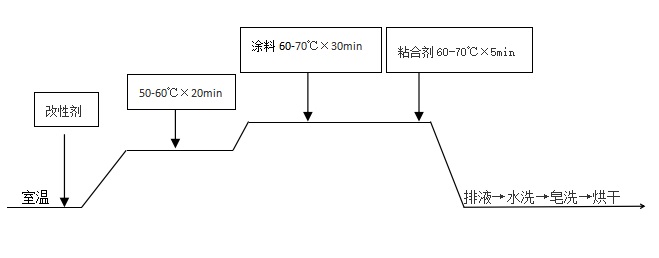I. Brief introduction:
The paint dip dyeing technology uses cationic modifying agent to cationize the fibers, thereby increasing the dye uptake and fixing the rate of the coating, reducing the discharge of dyeing waste water, and reducing the overall cost of dyeing. Paint dip dyeing is suitable for small batch and multi-variety production. It is able to respond quickly to the current changing market, meet market demand, and has broad application prospects.
II. Test process:
1 Test material and equipment.
1.1 Material: cotton white cloth.
1.2 Chemical: normal cationic modifying agent, HT-566.
1.3 Equipment: high temperature dyeing sample machine, 101-3 electric heating constant temperature blast drying oven.
1.4 Test index: coloring effect of cotton cloth.
2 Test process
2.1. Paint dyeing:
Cationic modifying agent: 3g/L, 60℃×20min→Drain
Pigment: 6% owf, 70℃×30min
Binding agent: 0.5-1% owf, 70℃×5min
Draining → Washing → Soaping and Drying.

Discharging → washing → soaping and drying
3 Test result.
3.1 Pigment Cotton Fabric
2% coating | Without a modifier | Cationic modifiers on the market | Honghao cationic modifier |
Paint red |
|
|
|
Paint yellow |
|
|
|
Paint blue |
|
|
|
4% coating | Without a modifier | Cationic modifiers on the market | Honghao cationic modifier |
Paint red |
|
|
|
Paint yellow |
|
|
|
Paint blue |
|
|
|
The test result show that HT-566 has a better coloring effect than normal cationic modifying agent.
III. Properties conclusion.
1. Pigment printing and dyeing technology has the advantages of simple process, complete chromatogram, strong adaptability, low cost, energy and water saving, and low pollution.
2. It can obtain the acceptable colorfastness even with reducing of binding agent , and improve the hard hand feeling of pigment-dyed fabrics.



 English
English  日本語
日本語  Español
Español  tiếng việt
tiếng việt  Türkçe
Türkçe  ไทย
ไทย  українська
українська  हिंदी
हिंदी  বাঙালি
বাঙালি  اردو
اردو 


















